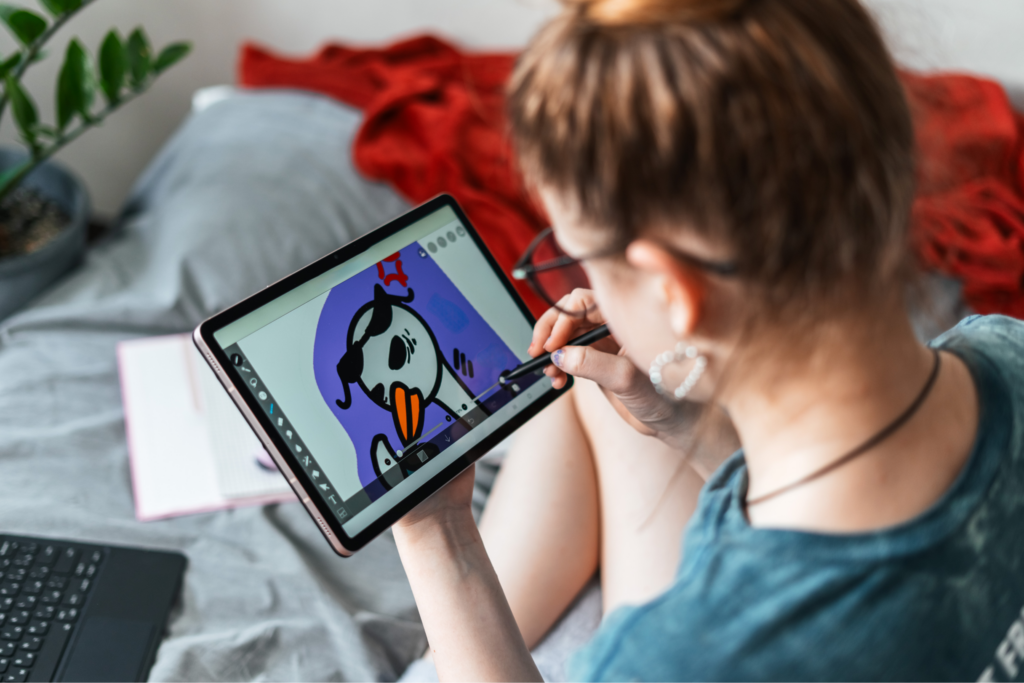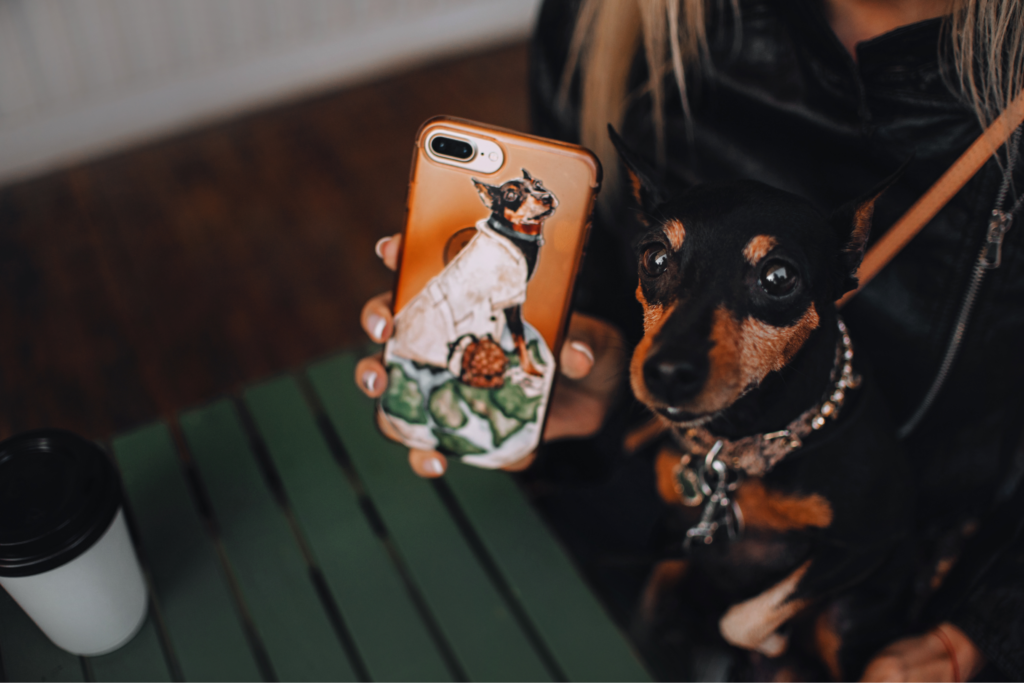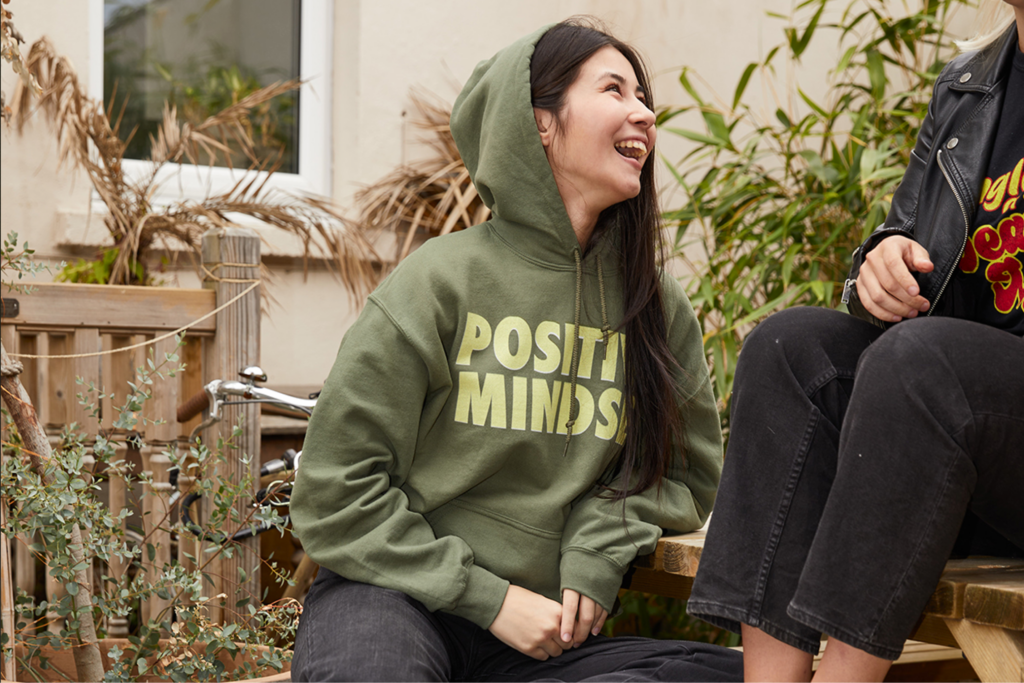Make a shirt with Printify today
What is DTF printing? It’s a direct-to-film printing method that creates sharp, long-lasting DTF prints on cotton, polyester, blends, and select non-textile surfaces. Since direct-to-film (DTF) printers work on all kinds of materials, it’s a solid choice for custom products. In this article, we’ll explain how the DTF printing process works and how it can fit into your business.
Key takeaways
- How it works: DTF is a digital printing type that uses printed film, DTF printer ink, and a heat press to transfer designs onto fabric. DTF printing requires a DTF printer, PET film, hot-melt adhesive powder, and a high-resolution print design.
- Quality and durability: The DTF process produces long-lasting and vivid designs due to its quality DTF ink. DTF-printed t-shirts and other items can withstand multiple washes and wears.
- Versatility: DTF printing works on various fabrics, including cotton, polyester, multi-substrate blends, and even non-textile materials like leather and wood.
- Compared to other printing methods: DTF (direct-to-film) is challenging to manage but delivers intricate prints and works with more fabric types than other printing methods.
- Merchandising: Printify offers multiple DTF Print Providers, so sellers get high-quality DTF products without managing specialized equipment.
DTF printing: Meaning explained
So, what does DTF mean in printing? It’s a direct-to-film printing method where a design is first printed onto PET film, coated with hot-melt adhesive powder, and then heat-pressed onto fabric for a clean, durable transfer.
This process uses a DTF printer and high-quality digital files to ensure sharp detail and long-lasting results. One of the reasons DTF printing technology has gained traction in the custom printing industry is its versatility – it works on a wide range of materials, including:
- Cotton
- Polyester
- Fabric blends
- Leather
- Nylon
- Select non-textile surfaces
Unlike some other printing methods, DTF printing doesn’t require fabric pre-treatment. That makes it faster and easier for sellers looking to offer durable and vibrant transfers across a wide product range.
How does DTF printing work?

When you outsource to Print Providers through Printify, you don’t have to worry about handling equipment or materials yourself. Here’s a simplified look at the DTF printing process behind the scenes:
1. Preparing the design
Create a high-resolution design (300 dpi) using Photoshop or Illustrator. Save it as a PNG file with a transparent background, then upload it to the Product Creator to place it on your item.
2. Setting up the DTF printer and software
First, what is a DTF printer? It’s a specialized inkjet printer that prints high-resolution designs onto PET film. It also prints a white ink layer beneath the colored inks for vibrant, full-coverage transfers.
Print Providers load CMYK and white ink, run test prints to verify color accuracy and ink flow, and use RIP software to prepare the file for printing.
3. Preparing the DTF film
The design is printed onto a PET DTF film. Operators ensure the film is clean, dust-free, and aligned to prevent defects.
4. Pre-pressing the fabric
The garment is lightly pressed with a heat press to remove moisture and wrinkles, which improves adhesion and final print quality.
5. Transferring the design
The printed film is coated with hot-melt adhesive powder, then cured with heat. The operator places the film on the garment and uses a heat press machine to bond the design. After pressing, the film is peeled away, leaving a clean, durable DTF print.

Pros and cons of DTF printing
Compared to other types of shirt printing, direct-to-film offers both high product versatility and fast production. But even this printing technique has its drawbacks.
Pros:
- Versatility: Compatible with various fabrics, even non-textile materials like leather and wood.
- Quality: Vibrant, long-lasting prints that withstand multiple washes.
- Efficiency: Quick setup and production times, reducing turnaround times.
- Cost-effectiveness: Perfect for colorful, intricate designs in small to medium print runs.
Cons:
- Adhesive powder: Gets messy and requires careful handling to avoid contamination.
- Specialized film: Uses PET film, raising material and operational costs from specialized suppliers.
- Fume ventilation: Generally non-toxic, but ventilation is still necessary to avoid prolonged exposure to skin, eyes, and lungs.
- Equipment maintenance: DTF printers and heat presses need regular maintenance to prevent issues like clogged nozzles or uneven heating.
For sellers who outsource, the pros come without the downsides. With Printify, you skip the specialized equipment, supply costs, and maintenance. Our Print Providers handle the entire DTF printing process, so you can offer high-quality DTF products like custom clothing and others without managing production.
DTF vs DTG printing
While DTF printing transfers printed film onto fabric with heat, direct-to-garment printing (DTG) directly applies ink to the fabric. Both methods use advanced inkjet printer technology but offer different benefits.
Versatility:
- DTG printing: Prints designs directly onto the fabric (cotton and cotton blends only) with no need for a transfer process. DTG prints are popular for smaller and more specialized batches.
- DTF printing: Bigger fabric versatility – handles cotton, polyester, blends, and more using PET film. Produces durable prints that resist cracking and fading.
Efficiency:
- DTG printing: Generally faster for small runs.
- DTF printing: More efficient for medium to large batches.
Simplicity:
- DTG printing: A direct-to-garment printer requires pre-treatment of the fabric for optimal results.
- DTF printing: Doesn’t require pre-treatment, simplifying the overall printing process and reducing preparation time.
DTF vs sublimation printing
Sublimation printing and DTF printing serve different needs in the custom printing industry, especially when it comes to fabric types and production requirements. Sublimation uses heat to infuse dye into polyester fabrics, which produces vivid, long-lasting results.

Versatility:
- Sublimation printing: This printing process works best at high temperatures and is mainly limited to polyester or polyester-coated substrates. Not suitable for organic fabrics like cotton, which scorch or fail to bond with sublimation dye.
- DTF printing: Supports a broader range of materials, including cotton, polyester, blends, leather, nylon, and select non-textile surfaces. DTF transfers work on more products, supporting bigger catalogs.
Durability:
- Sublimation printing: Produces excellent print quality and wash resistance since the dye becomes part of the fabric – but only on light-colored, polyester-rich garments.
- DTF printing: Produces durable and vibrant transfers on both dark and light fabrics. While DTF designs sit on top of the material (not infused), they still hold up well over time when applied with a heat press machine.
Cost and setup:
- Sublimation printing: Requires specialized materials like sublimation ink, coated surfaces, and transfer paper. These add to printing costs, and setup is more complex.
- DTF printing: Though it requires a DTF printer, film, and hot melt adhesive powder, it tends to be more cost-effective for sellers who need flexibility and lower printing volume minimums.
Cost doesn’t have to be a barrier. When you work with one of Printify’s Print Providers, you unlock pro DTF printing technology without the upfront investment in specialized equipment, making it easy to offer high-quality custom products at scale.
DTF vs screen printing

Screen printing is a traditional printing method often used for high-volume orders. It applies wet ink through a stencil (or screen) directly onto fabric, creating bold, durable prints. This technique is common in bulk production and is widely used in the printing industry.
Setup time:
- Screen print transfers: Requires a separate screen for each color, making setup slow and impractical for frequent design changes or one-off items.
- DTF printing: Faster and easier to set up. Designs are printed on DTF film, treated with hot melt powder, and transferred using a heat press machine. This fits better for on-demand printing and small-batch customization.
Volume:
- Screen printing: Best for large production runs of a single design. The more you print, the lower the printing costs per unit. Ideal for mass production.
- DTF printing: More efficient for smaller to medium-sized runs. It’s a good option for sellers offering custom t-shirt printing, limited editions, or frequently changing artwork.
Detail and color:
- Screen printing: Produces high-quality results but is limited in terms of fine details, gradients, or full-color designs.
- DTF printing: Excels with intricate details, bright colors, and even photo-realistic images thanks to advanced DTF printer technology.
Other printing methods to consider
Some businesses also use white toner laser printing to transfer designs onto dark fabrics. It offers decent print quality and works for short runs, but it’s less durable, less vibrant, and far less versatile than DTF printing or DTG printing. It also has limited compatibility with different fabric types.
How to start selling DTF products with Printify
Selling DTF products with Printify is simple. It’s free to start, and you only pay once you sell a product – no equipment (DTF printers, heat presses, etc.) necessary.
Here’s how to get started.
1. Select a product
Browse the Printify Catalog and use the Decoration method filter to find products compatible with DTF printing.
2. Prepare the print file
Ensure your design meets the DTF print file requirements, including PNG format, transparent background, correct print size, and 300 dpi resolution. You’ll find everything you need inside the Product Creator.
3. Apply your design
Upload your design and adjust the placement, size, and orientation to fit the product perfectly.
Then, use the Preview feature to see how the final product will look and edit as necessary.
4. Order or start selling
Order a sample to check print quality. Once you’re happy with the result, publish the product to your store. Printify connects with major eCommerce platforms, making it easy to market your DTF products and grow your printing business.

FAQ
It depends on your goals. DTF printing is more versatile. It works on cotton, blends, polyester, and even some non-textile surfaces. Sublimation is ideal for polyester-rich materials and coated hard substrates. Both methods have strengths – DTF wins on material range, sublimation wins on pure vibrancy for polyester.
DTF printing is perfect for custom apparel like t-shirts, promotional products, and other merchandise requiring high-quality, durable prints. The DTF process is particularly popular for t-shirts, hoodies, bags, and other fabric items, but is also compatible with non-textile materials like leather.
High-quality DTF prints can last 50-100 washes without major fading, cracking, or peeling when produced with proper DTF printer ink, hot-melt adhesive powder, and correct heat press settings. With good materials and care, they can last the lifetime of the garment.
A print DTF transfer is a design printed onto PET film, coated with adhesive powder, and then heat-pressed onto fabric. It produces vivid colors, fine detail, and consistent print quality across different products like t-shirts, hoodies, and more.
DTF printing is better for full-color, detailed designs and works on a wider range of materials. It’s ideal for custom t-shirt printing and on-demand printing. Vinyl printing (HTV) is simpler and more affordable to start, but is best for basic text or single-color logos. Each printing method has its strengths depending on your needs.
Why DTF is a smart choice for your printing business
DTF printing is a reliable way to create high-quality, custom products across a wide range of materials. It’s simple to get started, even if you’re new to printing.
Printify gives you access to 1,300+ products, multiple DTF Print Providers, and seamless store integrations, so you can launch and scale DTF products without buying specialized equipment or managing production.Choose a DTF Print Provider that matches your goals and start creating today!












